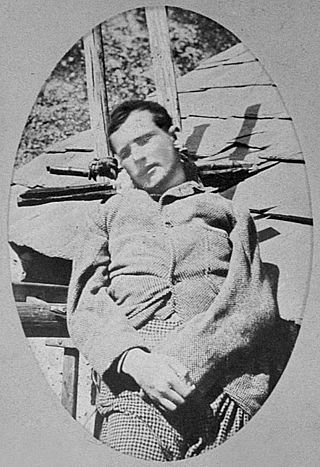
Kangchenjunga, also spelled Kanchenjunga, Kanchanjanghā and Khangchendzonga, is the third-highest mountain in the world. Its summit lies at 8,586 m (28,169 ft) in a section of the Himalayas, the Kangchenjunga Himal, which is bounded in the west by the Tamur River, in the north by the Lhonak River and Jongsang La, and in the east by the Teesta River. It lies in the border region between Koshi Province of Nepal and Sikkim state of India, with the two peaks West and Kangbachen in Nepal's Taplejung District and the other three peaks Main, Central and South directly on the border.

Arnold Escher von der Linth was a Swiss geologist, the son of Hans Conrad Escher von der Linth (1767–1823).

George Christopher Band was an English mountaineer. He was the youngest climber on the 1953 British expedition to Mount Everest on which Edmund Hillary and Tenzing Norgay became the first to ascend the mountain. In 1955, he and Joe Brown were the first climbers to ascend Kangchenjunga, the third highest mountain in the world.

Douglas William Freshfield was a British lawyer, mountaineer and author, who edited the Alpine Journal from 1872 to 1880. He was an active member of the Royal Geographical Society and the Alpine Club and served as President of both organizations. He was also the first president of the Geographical Association, being one of the people at the first meeting where the Association was founded. He served from 1897 to 1911, the longest serving president in the history of the Association.
The Alpine Club was founded in London on 22 December 1857 and is the world's first mountaineering club. The primary focus of the club is to support mountaineers who climb in the Alps and the Greater Ranges of the world's mountains.

The Canadian Alpine Journal is the yearly magazine of the Alpine Club of Canada. It serves as a worldwide journal of record for achievements in climbing, mountaineering, ski mountaineering, and exploration of mountains. The magazine is headquartered in Toronto, Ontario.

The golden age of alpinism was the decade in mountaineering between Alfred Wills's ascent of the Wetterhorn in 1854 and Edward Whymper's ascent of the Matterhorn in 1865, during which many major peaks in the Alps saw their first ascents.

Clinton Thomas Dent FRCS was an English surgeon, author and mountaineer.

Adolphus Warburton Moore (1841–1887) was a British civil servant and mountaineer.

Edward Shirley Kennedy (1817–1898) was an English mountaineer and author, and a founding member of the Alpine Club.

Francis Fox Tuckett FRGS was an English mountaineer. He was vice-president of the Alpine Club from 1866 to 1868, and a Fellow of the Royal Geographical Society.

The Fritz Pflaum Hut is an Alpine club hut belonging to the Bayerland Section of the German Alpine Club, located in the Kaisergebirge mountains in the Austrian federal state of Tyrol.

Thomas Middlemore was an English mountaineer who made multiple first ascents during the silver age of alpinism. His audacity earned him a reputation as the enfant terrible within the Alpine Club. He was also the head of the Middlemores Saddles leather goods company in Birmingham, England, after the retirement of his father, William Middlemore, in 1881. Thomas Middlemore had taken over the management of the company in 1868 and established a bicycle saddle factory in Coventry.

Henri Cordier or Henry Cordier was a French mountaineer. In his short two-year career, he became the first Frenchman to reach the level of the English members of the Alpine Club, in the silver age of alpinism in the second half of the 19th century, which was dominated by the development of mountaineering in the Alps. With some of the Alpine Club's mountain guides and mountaineers, he led significant first ascents in the Mont Blanc massif and in the Dauphiné Alps.
Sir John Oakley Maund was an English banker, stockbroker, entrepreneur, hunter and mountaineer during the silver age of alpinism.
Arthur John Butler, was an English scholar, editor, and mountaineer, professor of Italian language and literature at University College London.
Thomas Woodbine Hinchliff was an English mountaineer, traveller, and author, from 1875 to 1877 the seventh President of the Alpine Club.
George Yeld (1845–1938) was a schoolmaster, climber, explorer and hybridiser of daylilies and irises. He was a member of the Alpine Club and editor of the Alpine Journal. Much of his climbing and exploration was conducted with volcanologist Tempest Anderson and he published reports of his exploits and produced introductory books on Latin for scholars. Yeld received the Victoria Medal of Honour from the Royal Horticultural Society in 1925.
Lungser Kangri is a mountain located in Ladakh, India.













